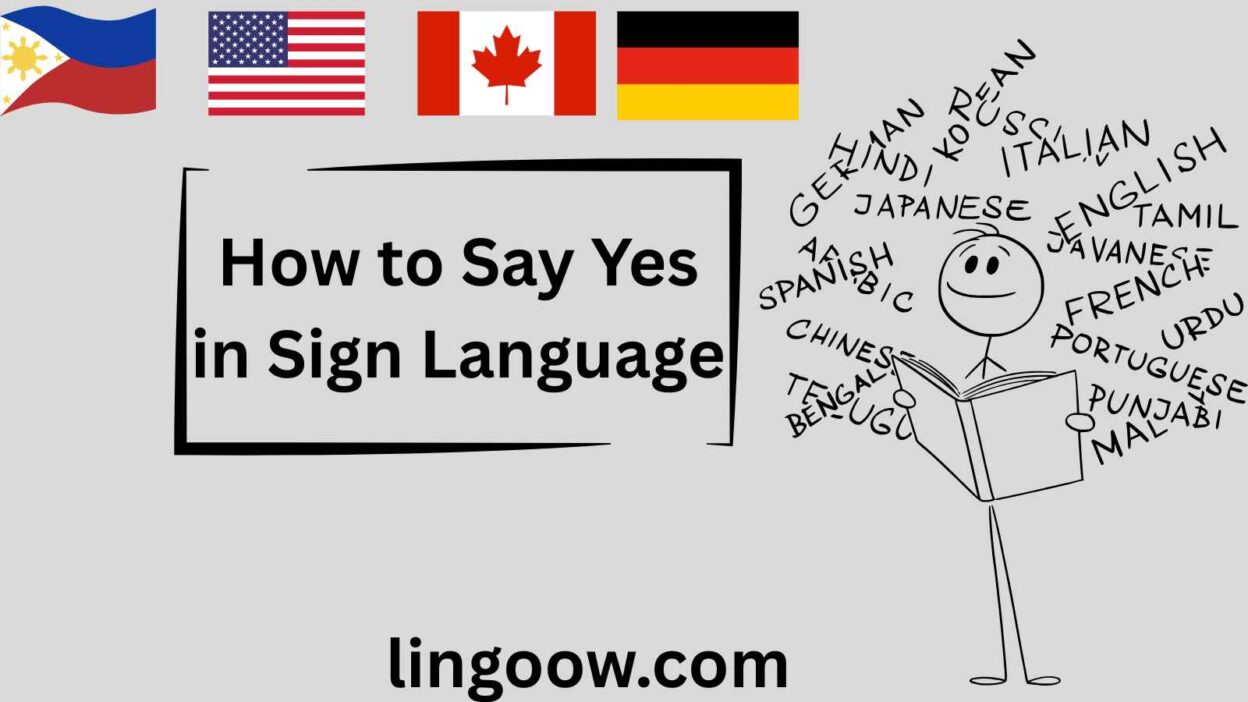Imagine a crowded airport in Tokyo. A lost traveler, clutching a crumpled map, approaches a stranger with a hesitant smile.
No shared spoken words, but a simple nod, a thumbs-up, a warm grin—and suddenly, connection.
That moment of affirmation, of yes, bridges worlds without a single syllable. Across the globe, “yes” is more than agreement; it’s trust, openness, the quiet heartbeat of human connection.
And in sign language? It’s a fist gently nodding at the wrist—like the head’s silent echo, universal in its simplicity.
But spoken “yes” varies wildly, shaped by history, geography, and spirit. Yet beneath the differences lies a shared truth: every culture has found a way to say I’m with you. Let’s travel the world, one yes at a time.
Quick Reference Table: “Yes” in 15+ Languages
| Language | Word/Phrase | Cultural Insight |
| American Sign Language (ASL) | Fist nod (wrist forward) | Direct, efficient; used in Deaf culture as a full sentence. |
| French | Oui | Soft, melodic; often paired with a smile or shoulder shrug. |
| Spanish | Sí | Emphasized with rising intonation; double “sí, sí” shows enthusiasm. |
| Italian | Sì | Sung-like; hand gesture (pinched fingers upward) amplifies meaning. |
| German | Ja | Crisp, decisive; rarely overused—Germans value precision. |
| Mandarin Chinese | 是 (shì) / 好的 (hǎo de) | Context-dependent; “shì” confirms facts, “hǎo de” agrees to action. |
| Hindi | हाँ (hāṅ) | Nasal, warm; often repeated or paired with head wobble. |
| Japanese | はい (hai) | Polite, formal; bowing deepens sincerity. |
| Korean | 네 (ne) / 예 (ye) | “Ne” casual, “ye” formal; tone matters more than word. |
| Arabic | نعم (naʿam) | Resonant, respectful; used in religious and daily contexts. |
| Swahili | Ndiyo | Rhythmic; often sung in greetings or songs. |
| Zulu | Yebo | Bright, affirmative; used in call-and-response traditions. |
| Yoruba | Bẹ́ẹ̀ ni | Literal: “It is so”; deeply tied to truth and honor. |
| Māori | Āe | Soft, flowing; reflects harmony with land and people. |
| Hawaiian | ʻAe | Gentle, breathy; embodies aloha spirit of welcome. |
European Languages: Precision, Passion, and Politeness
In Europe, “yes” dances between logic and emotion.
- French – Oui The French say oui like a sigh of relief. It’s light, almost musical. In Provence, you might hear ouais—a casual, throatier version among friends. Refusing is rude; affirming is art.
- Spanish – Sí In Spain, sí explodes with energy. In Argentina, it’s drawn out—sííí—like a promise. Paired with a kiss on the cheek, it seals friendships.
- Italian – Sì Italians don’t just say sì—they perform it. Hand pinched, palm up, eyes wide. It’s theater. Refusal? A sharp no with a head shake. Balance is everything.
- German – Ja Direct. Final. Ja means yes, and that’s that. In Bavaria, you might hear genau (“exactly”) as enthusiastic agreement. Efficiency is affection.
Asian Languages: Context, Respect, and Harmony (20+ Countries)
Asia’s “yes” is rarely just a word—it’s a relationship.
- Mandarin (China) – 是 (shì) / 好的 (hǎo de) “Shì” confirms truth. “Hǎo de” accepts a request. Silence can also mean yes—especially in family.
- Japanese (Japan) – はい (hai) Hai means “I’m listening,” not always “I agree.” True consent comes in tone, bow depth, and follow-through.
- Hindi (India) – हाँ (hāṅ) The famous Indian head wobble accompanies hāṅ. It’s not indecision—it’s warmth, nuance, yes, but let’s talk.
- Korean (South Korea) – 네 (ne) Hierarchy shapes yes. To elders: ye (formal). To friends: ung (casual grunt). Tone reveals sincerity.
- Arabic (20+ countries: Egypt, Morocco, UAE, etc.) – نعم (naʿam) From Cairo markets to Dubai boardrooms, naʿam is respectful, resonant. In Palestine, aywa is warmer, familial.
- Thai (Thailand) – ครับ / ค่ะ (kráp / kâ) Not yes, but polite particles. Men end with kráp, women kâ. Agreement is in the sound, not the word.
- Indonesian (Indonesia) – Ya Simple, direct—but paired with a smile and terima kasih (thank you), it builds community.
African Languages: Rhythm, Community, and Truth (20+ Countries)
In Africa, “yes” is often sung, danced, or spoken in unison.
- Swahili (Kenya, Tanzania, Uganda) – Ndiyo Call: “Habari?” Response: “Nzuri—ndiyo!” It’s rhythmic, communal. Hakuna matata? Ndiyo!
- Zulu (South Africa) – Yebo Bright, proud. In traditional ceremonies, yebo affirms ancestry, unity, respect.
- Yoruba (Nigeria, Benin) – Bẹ́ẹ̀ ni Literal: “It is so.” Truth is sacred. Saying bẹ́ẹ̀ ni is a vow.
- Amharic (Ethiopia) – አዎ (awo) Soft, ancient. Used in Orthodox Christian liturgy—awo to God, to elders, to coffee ceremonies.
- Hausa (Nigeria, Niger) – Eh Short, sharp, warm. In markets, eh wallahi means “yes, I swear!”
- Wolof (Senegal) – Waaw Melodic, repeated: waaw, waaw. Agreement is celebration.
Indigenous & Island Languages: Spirit, Land, and Legacy (20+ Countries)
Here, “yes” is tied to earth, ancestors, and survival.
- Māori (New Zealand) – Āe Spoken with mana (spiritual power). In haka, āe is a war cry of unity.
- Hawaiian (Hawaii) – ʻAe Breath is life. ʻAe is exhaled gently—like wind through palms. It means yes to life.
- Cherokee (USA) – ᎥᏝ (vhna) Rare in writing, rich in tone. Used in storytelling—affirming history, healing.
- Samoan (Samoa, American Samoa) – Ioe Loud, proud. In ava ceremonies, ioe seals brotherhood.
- Inuit (Canada, Greenland) – Ii Short, nasal. In throat-singing duets, ii is harmony.
- Quechua (Peru, Bolivia) – Arí Andean winds carry arí. It means yes to the mountains, to the ancestors.
Cultural Insights: The Evolution of Yes
The oldest known “yes”? Sumerian e (circa 3000 BCE)—a simple affirmation etched in clay. In ancient Egypt, ii meant both “yes” and “life.” Sanskrit asti (“it is”) birthed Hindi hai and English is.
In medieval Europe, knights swore oui on swords. In feudal Japan, samurai bowed with hai—loyalty in silence. In West Africa, griots sang yebo in epics, binding tribes.
Religiously?
- Christianity: Amen = “so be it”
- Islam: Naʿam in prayer
- Buddhism: Silent nod—agreement beyond words
Proverbs & Sayings About Yes
- Japanese: 「はいが百両」 (Hai ga hyaku ryō) – “One ‘yes’ is worth a hundred gold coins.”
- Yoruba: Ọ̀rọ̀ ẹni ni ẹ̀yẹ ẹni – “Your word is your bird; once released, you can’t catch it.” (Say yes wisely.)
- Italian: Chi dice sì, apre una porta – “Who says yes, opens a door.”
- Zulu: Yebo liyazuzisa – “Yes brings joy.”
- Hawaiian: ʻAe me ka ʻoluʻolu – “Yes with kindness.”
FAQs
Why do so many languages have short, nasal “yes” sounds?
Linguists say it’s biological—open vowels (ah, oh) for emotion, closed nasals (m, n) for quick affirmation. Easy on the tongue, fast in the brain.
What’s the oldest recorded “yes”?
Sumerian e (3000 BCE), meaning “it is so.”
Why don’t some cultures say “yes” directly?
In Japan or Korea, direct yes can seem rude. Context, tone, and silence carry weight. It’s not evasion—it’s respect.
Is sign language “yes” universal?
The ASL fist-nod is widely understood, but British Sign Language uses a flat hand tap. Still, the spirit of yes? Always clear.
Conclusion: The Quiet Power of Yes
From a Tokyo nod to a Zulu yebo, from a Parisian oui to a Cherokee vhna, one truth remains: yes is how we say “I see you. I’m here. Let’s begin.”
It opens doors, heals wounds, builds empires, and mends hearts. It’s the first word in every love story, every revolution, every friendship.




